FY2021 Annual Report
Theory of Quantum Matter Unit
Professor Nic Shannon
Abstract
FY2021 was a year in which the TQM Unit slowly returned to a more normal working routine, and undertook is second "Unit Review".
Following OIST's successful COVID vaccination campagne, the majority of Unit members returned to working at their desks, and resumed travel within Japan. The TQM virtual seminar series continued, with 20 talks being given over he course of the year, with topics ranging from entanglement witnseses in quantum magnets to the ramifications of the Ahranov-Bohm effect.
The unit published 6 papers in FY2021, with one appearing as a Letter. Research highlights included the release of the new high-field exact diagonalisaion code QS3; a landmark study of multicriticality in Ising models; a new approach to speeding up optimisation calculations on quantum computers; a method for imaging magnetic monopoles in spin ice; a novel approach to simulating spin-1 magnets; and a pioneering study of the dynamics of multiple-phase competition, in the context of Yb2Ti2O7.
With international conferences still largely suspended, the major event of the year was the TQM Unit's second Unit Review. In this, work carried out by the TQM Unit between 2016 and 2021 was evaluated by a panel of five external experts, with members from Japan, Korea, Italy, Germany and the UK. The review was based on documents submitted by the Unit, and on a series of Zoom presentations and intereviews with panel members, carried out over a week in September. The panel's report delivered a strong endorsement of the TQM Unit's current research and future plans.
FY2021 also saw a number of other important events in the life of the Unit. In April, Dr Tokuro Shimokawa was awarded a second Kakheni grant, supporting his research on quantum spin systems in high magnetic field. In May former TQM Unit member Dr Han Yan was awarded the Peter Gruss Doctoral Excellence Award for his PhD Thesis. In July, the Unit celebrated the successful PhD defence (by Zoom) of Andreas Thomasen, co-supervised by Prof. Judit Romhanyi (UC-Irvine). Shortly afterwards, Dr Thomasen left OIST to take up a job at the quantum computing company QunaSys. In January the Unit was pleased to welcome two new PhD students, Mr Jiahui Bao and Mr Snigdh Sabharwal. And in March former TQM Unit member, Dr Rico Pohle, won the Young Researcher Award of the Kakheni Innovative Research Area project on Quantum Liquid Crystals, for work carried out in collaboration with the TQM Unit.
Despite the barriers to travel outside Japan, Unit members remained very active in international collaborations, and in presenting their results (virtually) at international conferences and seminar series. In total Unit members gave 19 talks in FY2020, including an invited talk at Pacifichem 2021, the 5-year meeting of Asis-Pacific chemical societies.
1. Staff
- Dr. Matthias Gohlke, Postdoctoral Scholar
- Dr. Geet Rakala, Postdoctoral Scholar
- Dr. Tokuro Shimokawa, Postdoctoral Scholar
- Dr. Jonas Sonnenschein, Postdoctoral Scholar
- Mr. Jiahui Bao, PhD Student (2022 Jan -)
- Ms. Leilee Chojnacki, PhD Student
- Mr. Soshi Mizutani, PhD Student
- Ms. Kimberly Remund, PhD Student
- Mr. Snigdh Sabharwal, PhD Student (2022 Jan -)
- Ms. Ananya Samanta, PhD Student
- Mr. Andreas Thomasen, PhD Student (-2021 July)
- Ms. Megumi Ikeda, Research Unit Administrator
2. Collaborations
2. 1 Search for Quantum Spin Liquids in extended Kitaev Models
- Researchers:
- Dr. Matthias Gohlke, OIST
- Mr. Jose-Carlos Pelayo, OIST
- Associate Prof. Takafumi Suzuki, University of Hyogo
2. 2 Interaction-Induced Magnon Degeneracy Breaking
- Researchers:
- Mr. Alberto Corticelli, MPIPKS Dresden
- Dr. Matthias Gohlke, OIST
- Dr. Alexander Mook, Uni Basel
- Dr. Paul McClarty, MPIPKS Dresden
2. 3 Spin-Nematic Order in Square-Lattice Frustrated Ferromagnets
- Researchers:
- Dr. Matthias Gohlke, OIST
- Dr. Jonas Sonnenschein, OIST
- Dr. Tokuro Shimokawa, OIST
- Prof. Nic Shannon, OIST
2. 4 Development of the exact diagonalization method for near saturation fields
- Researchers:
- Dr. Tokuro Shimokawa, OIST
- Dr. Hiroshi Ueda, Osaka University
- Dr. Seiji Yunoki, RIKEN
2. 5 Low-temperature physics in the quantum spin liquid state of a quantum bilayer-breathing-kagome magnet
- Researchers:
- Dr. Tokuro Shimokawa, OIST
- Dr. Rico Pohle, University of Tokyo
- Prof. Nic Shannon, OIST
2. 6 High-field magnetism in the S=1/2 honeycomb-lattice antiferromagnet Cu2(pymca)3(ClO4)
- Researchers:
- Dr. Tokuro Shimokawa, OIST
- Dr. Akira Okutani, Fukui University
- Prof. Zentaro Honda, Saitama University
- Prof. Masayuki Hagiwara, Osaka University
- Prof. Takano Kenichi, Toyota Technological Institute
2. 7 Multiple-q states in a frustrated honeycomb-lattice magnet
- Researchers:
- Dr. Tokuro Shimokawa, OIST
- Dr. Rico Pohle, University of Tokyo
2. 8 Multicritical pinch-off in triangular lattice antiferromagnets
- Researchers:
- Dr. Geet Rakala, OIST
- Dr. Nisheeta Desai, TIFR
- Prof. Kedar Damle, TIFR
2. 9 Hard plates on a cubic lattice
- Researchers:
- Dr. Geet Rakala, OIST
- Dr. Dipanjan Mandal, Univ. of Warwick
- Prof. Kedar Damle, TIFR
- Prof. Rajesh R, IMSc
- Prof. Deepak Dhar, IISER
2. 10 Cluster algorithm using Variational Autoregressive Neural Net
- Researchers:
- Dr. Geet Rakala, OIST
- Prof. Nic Shannon, OIST
2. 11 Calculating corner charges from insulating many-body wave functions
- Researchers:
- Dr. Jonas Sonnenschein, OIST
- Dr. Luka Trifunovic, University of Zürich
2. 12 SUSY quantum mechanics on a lattice
- Researchers:
- Dr. Jonas Sonnenschein, OIST
- Dr. Mirian Tsulaia , OIST
2. 13 Majorana zero Modes and Topological Entanglement Entropy of the Kitaev Honeycomb Model
- Researchers:
- Mr. Snigdh Sabharwal, OIST
- Dr. Matthias Gohlke, OIST
- Mr. Jiahui Bao, OIST
2. 14 Negative Thermal Expansion in a Magnetically Frustrated Spinel
- Researchers:
- Ms. Ananya Samanta, OIST
- Dr. Han Yan, Rice University
- Prof. Karlo Penc, Wigner Research Centre for Physics, Hungarian Academy of Sciences
- Prof. Nic Shannon, OIST
2. 15 Analogues of light and gravity in the collective excitations of quantum magnets
- Researchers:
- Ms. Leilee Chojnacki, OIST
- Dr. Rico Pohle, University of Tokyo
- Dr. Han Yan, OIST & Rice University
- Prof. Nic Shannon, OIST
- Prof. Yutaka Akagi, University of Tokyo
2. 16 Numerical investigation of spin-1 magnets on the pyrochlore lattice
- Researchers:
- Ms. Leilee Chojnacki, OIST
- Dr. Rico Pohle, University of Tokyo
- Prof. Nic Shannon, OIST
2. 17 Numerical simulation of spin-1 magnets
- Researchers:
- Ms. Kimberly Remund, OIST
- Dr. Rico Pohle. University of Tokyo
- Prof. Yutaka Akagi, University of Tokyo
- Prof. Judit Romhanyi, University of California Irvine
- Prof. Nic Shannon, OIST
2. 18 Generalization of SCGA to spin-1 magnets
- Researchers:
- Ms. Kimberly Remund, OIST
- Dr Owen Benton, MPI-PKS Dresden
- Prof. Nic Shannon, OIST
2. 19 Entanglement properties of Kitaev honeycomb model
- Researchers:
- Ms. Jiahui Bao, OIST
- Ms. Snigdh Sabharwal, OIST
- Dr. Matthias Gohlke, OIST
2. 20 Quantum Approximate Optimization Algorithm with Adaptive Bias Fields
- Researchers:
- Mr. Yunlong Yu, Tsinghua University, Beijing
- Mr. Chenfeng Cao, Hong Kong University of Science and Technology
- Mr Carter Dewey, University of Wisconsin, Madison
- Prof. Xiang-Bin Wang, Tsinghua University, Beijing
- Prof. Robert Joynt, University of Wisconsin, Madison
- Prof. Nic Shannon, OIST
2. 21 Mitigating Algorithmic Errors in Quantum Optimization with Energy Extrapolation
- Researchers:
- Mr. Chenfeng Cao, Hong Kong University of Science and Technology
- Mr. Yunlong Yu, Tsinghua University, Beijing
- Mr. Zipeng Wu, Hong Kong University of Science and Technology
- Prof. Bei Zeng, Hong Kong University of Science and Technology
- Prof. Robert Joynt, University of Wisconsin, Madison
- Prof. Nic Shannon, OIST
2. 22 Dynamical scaling as a signature of multiple phase competition in Yb2Ti2O7
- Researchers:
- Dr A. Scheie, ORNL Tennessee
- Dr O. Benton, MPI-PKS Dresden
- Dr M. Taillefumier, ETH Zurich
- Dr L.D.C. Jaubert, CNRS Bordeaux
- Dr G. Sala, ORNL Tennessee
- Dr N. Jalarvo, ORNL Tennessee
- Dr S.M. Koohpayeh, JHU Baltimore
- Prof N. Shannon, OIST
3. Activities and Findings
3.1 Semi-classical simulation of spin-1 magnets
Spin-1 is special. Indeed, beside displaying dipolar degrees of freedom, a spin-1 can also exhibit on-site quadrupolar degrees of freedom, while retaining its quantum characteristics. Therefore, spin-1 systems have often been use to refer to spin-nematic order in magnetic insulators, Fe-based superconductors or cold atoms. Unlike for spin-1/2, which in the classical limit can be represented by an O(3) vector, for spin-1, an O(3) vector does not completely describe all of what a spin-1 can do. This is due to the fact that a spin-1 intrinsically has quadrupoles, which cannot be describe by an O(3) vector.
In this work, we develop a method based on the extension of the usual su(3) algebra describing a quantum spin-1 into the u(3) algebra. This allows a united framework which enables us to treat dipolar and quadrupolar degrees of freedom on an equal footing. Within our u(3) formalism, we derive equations of motion (EoM) for the objects living in the u(3) algebra, which take a simple form suitable for numerical implementation. Moreover our u(3) approach enables the appropriate formulation to both classical and quantum derivations.
We illustrate our method by applying it to the well-known Bilinear-Biquadratic model on the triangular lattice for the ferroquadupolar state. We support our study through classical low-temperature expansion and classical Monte Carlo (MC) in order to probe the thermodynamical properties as well as quantum multi-bosons theory and molecular dynamics (MD) simulations that allow us to access dynamics. We show that at sufficiently low temperature we can correct for the classical statistics in numerical simulations and retrieve the fully quantum zero-temperature analytical results. Finally, we confirm that our method is also applicable to anisotropic models, which is of experimental relevance.
These results open the door to the efficient simulation of spin-1 magnets, and of spin-1 models arising in the context of cold atoms, and Fe-based supercondcutors.
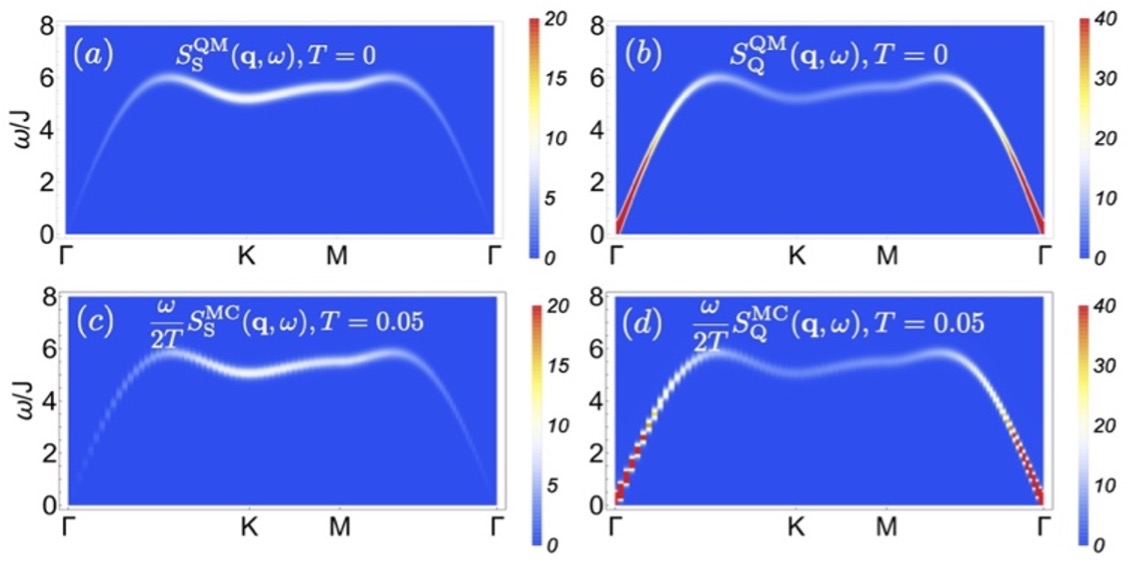
[Fig.] Dynamical structure factors for dipole SS(q, ω) [(a), (c)] and quadrupole SQ(q, ω) [(b), (d)] moments obtained by quantum multi bosons theory [(a), (b)] at T=0 and U(3) Molecular Dynamics simulations [(c), (d)] at low but finite temperature T=0.05 [J] [7].
This work was published as "Semi-classical simulation of spin-1 magnets" Kimberly Remund, Rico Pohle, Yutaka Akagi, Judit Romhànyi and Nic Shannon, Phys. Rev. Research 4, 033106 (2022)
3.2 Spinning on the edge...
Just as people are said to be "frustrated" when they experience conflicting desires, so magnets are said to be frustrated when it proves impossible to satisfy all of the interactions within them. In magnets, this can lead to a situation where radically different forms of magnet order lie very close in energy, and compete even at the scale of a few atoms. This has lead to a paradigm of "multiple-phase competition" explored in earlier work by the Theory of Quantum Matter (TQM) Unit.
Yb2Ti2O7 is one of the best studied of frustrated pyrochlore magnets, and provides one of the most compelling examples of multiple--phase competition. None the less, many of its properties, particularly with respect to dynamics, remain ambiguous. And exploring the consequences of multiple phase competition for dynamics has proved difficult, since it requires the ability to measure on the scale of micro electron volts (\mu eV). This is approximately one millionth of the energy of the chemical bonds within Yb2Ti2O7, and over a thousand times smaller than the energies usually measured in inelastic neutron scattering, the technique of choice for atomic--scale magnetic dynamics.
In a recent study, the TQM Unit have collaborated with experimental scientists based at Oak Ridge National Laboratory (ORNL) and John Hopkins University, as well as former TQM Unit members at MPI-PKS Dresden, CNRS and ETH Zurich, to shed new light on the dynamics of Yb2Ti2O7, at the scale of \mu eV. By making novel use of a neutron-scattering instrument originally designed to study liquids, our collaborators were able to resolve for the first time the energy dependence of "rods" of scattering, characteristic of Yb2Ti2O7.
Remarkably, when these data are plotted as a function of energy over temperature, experimental measurements taken at different energies and temperatures collapse onto a single curve, as shown in Figure 1. Dynamical scaling of this form is extremely unusual, and is found to be perfectly described by the theory of multiple phase competition.

[Fig 1] Dynamical scaling of low--energy excitations in Yb2Ti2O7, showing how experimental data measured at different energies and temperatures collapse onto a single curve. The scaling found in experiment exactly matches the prediction made by theory of multiple-phase competition (solid line).
This work was published as "Dynamical scaling as a signature of multiple phase competition in Yb2Ti2O7", A. Scheie, O. Benton, M. Taillefumier, L. D. C. Jaubert, G. Sala, N. Jalarvo, S. M. Koohpayeh, and N. Shannon, Phys. Rev. Lett. 129, 217202 (2022), open a new perspective for the mechanism of multiple-phase competition, which may be relevant to many different frustrated materials.
3.3 What would a magnetic monopole look like ?
The possibility of finding a magnetic monopole - a particle which acts a point--like source of magnetic field - has fascinated physicists for over a century. None the less, the existence of magnetic monopoles as elementary particles remains an enigma. And while there is compelling evidence for the existence of emergent excitations which behave like magnetic monopoles in spin ice, the direct observation of a point-like source of magnetic field in these materials remains an open challenge.
In this work, we explore what can be learnt about magnetic monopoles from holographic images taken with an electron microscope. This approach shows great promise since it combines the atomic-scale resolution needed to resolve an individual monopole, with extreme sensitivity to magnetic charge, through the Aharonov-Bohm effect. Through experiments on artificial spin ice, we show that holograms can be used to directly image magnetic monopoles, and measure their local magnetic charge. And through numerical simulations, we demonstrate that holographic experiments are capable of resolving magnetic monopoles in pyrochlore spin ice, and their dynamics.
These results suggest that the observation of magnetic monopoles in spin ice is a realistic possibility in an electron microscope with sufficiently-high phase resolution.
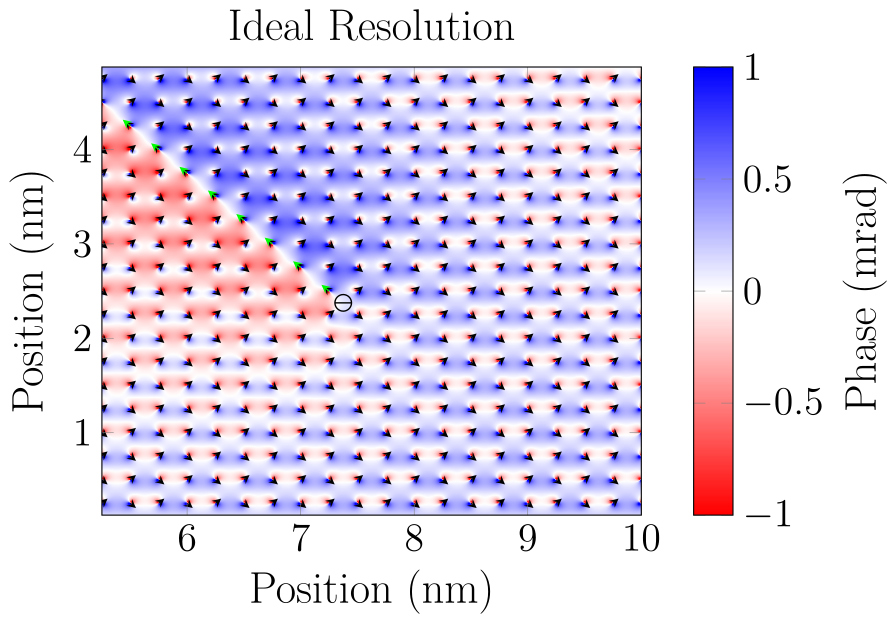
Signature of magnetic monopole, as found in simulations of electron-holographymeasurements of pyrochlore spin ice. The phase of an electron wave function picks up a branch cut after passing a magnetic monopole, visible here as a discontinuity the phase (white line). The jump in phase crossing this line measures the charge of the monopole.
These results is described in the preprint "Observing Magnetic Monopoles in Spin Ice using Electron Holography", Ankur Dhar, L. D. C. Jaubert, Cathal Cassidy, Tsumoru Shintake, and Nic Shannon, arXiv:2112.01362.
3.4 Making the most of the time (and qu-bits) available...
Quantum computers of the present, "noisy intermediate-scale quantum " (NISQ) era are severely limited in both the time for which they can run calculations, and the number of qu-bits on which they can run them. For this reason, every nanosecond of computational time, and every available qu-bit is precious. It is therefore of vital interest to identify approaches which can be used to maximise the accuracy of results obtained from finite resources, and in finite time.
In this work, a collaboration of the TQM Unit with researchers from The Hong Kong University of Science and Technology, Tsinghua University, and the University of Wisconsion-Madison, we show that simple extrapolations of results as a function of time, or variance (statistical error), can dramatically increase the accuracy of results obtained with limited resources. We do this through a mixture of numerical simulation, and explicit experimental demonstration, making use of "Jakarta", an IBM quantum computer based on superconducting qu-bits.
We find that extrapolations schemes can lead to (multiple) order-of-magnitude improvements in the accuracy obtained in three of the most popular approaches to quantum computing; quantum annealing; variational quantum eigensolvers (VQE); and quantum imaginary time evolution, at fixed evolution time or circuit depth. These results suggest that simple extrapolation techniques may prove an valuable resource for the NISQ era.

[Fig. 6c of preprint] Improvement in estimate of energy, E, obtained in a variational quantum eigensolver (VQE) algorithm run on the IBM Jakarta quantum computer, as a result of interpolation as a function of variance, Δ. The estimate of energy obtained after extrapolation is one order of magnitude better that the best result obtained in experiment.
These results are published as "Mitigating algorithmic errors in quantum optimization through energy extrapolation", Chenfeng Cao, Yunlong Yu, Zipeng Wu, Nic Shannon, Bei Zeng, Robert Joynt, Quantum Sci. Technol. 8 015004 (2022).
3.5 Parafermionic multicriticality in Ising models
The critical properties and associated universality of phase transitions in magnets can be well understood under Wilson’s renormalisation group (RG) framework in terms of the RG flows of the effective Hamiltonian where the nature of the transition is determined by the codimension of the ‘relevant’ coupling constants near the fixed points of the Hamiltonian. Apart from the translational, rotational and global scale invariance present at critical fixed points, a conformal invariance (local scale invariance) was first hypothesised by Polyakov in systems with local interactions.
The fixed points of two-dimensional lattice models with discrete symmetries are described by a class of minimal conformal models with known central charge. Moreover some lattice models show extended superconformal symmetry at criticality between bosons and associated Majorana fermions of the underlying conformal model, making them the first models to confirm the predicted but elusive realization of supersymmetry. In two dimensional planar models with discrete symmetries, a dual parafermionic conformal symmetry was shown to exist. Parafermions are spinful generalisations of Majorana fermions which obey non-Abelian statistics and have been proposed as a robust route to topological quantum computing.
Examples of conformal, superconformal and parafermionic symmetries in condensed matter systems abound and have been of sustained interest. However experimental access to these symmetries is extremely hard due to the presence of two or more ‘relevant’ coupling constants in the vicinity of the associated fixed points of the underlying effective Hamiltonian and thus requiring a fine-tuned control over the parameter space of the physical Hamiltonian.
In this work we study the frustrated antiferromagnetic Ising model on a triangular lattice with further neighbor couplings using worm algorithms. We numerically establish the presence of Z6 parafermionic multicriticality at the pinch-off point of the two-step melting transition. Moreover we show that this multicritical point controls the melting physics in a large experimentally accessible neighbourhood of parameter space.
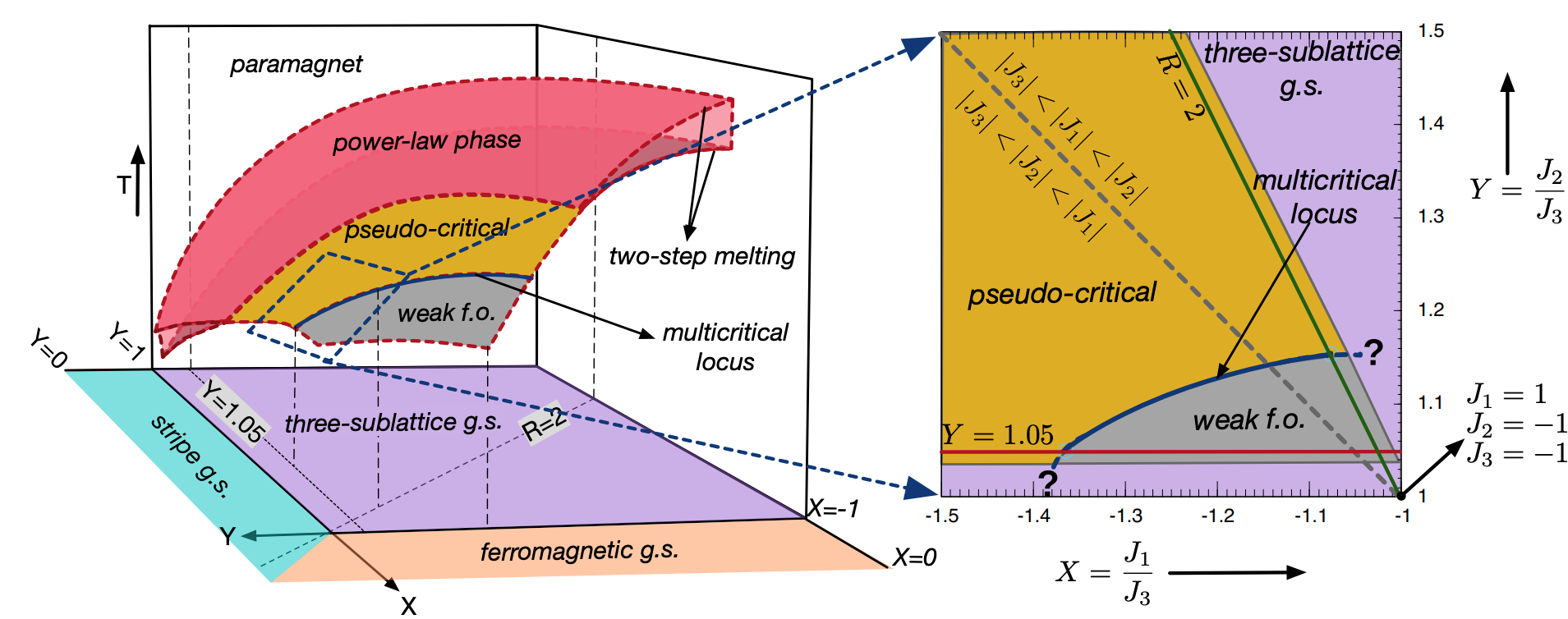
The figure shows the melting phase diagram of a triangular lattice antiferromagnet with upto third nearest neighbour interactions. The two-step melting of the three-sublattice order pinches-off into a multicritical locus in the Z6 parafermionic universality class. This multicritical locus controls the critical properties of a large range of experimentally accessible parameter space as shown in the zoomed in region on the right.
This work is described in the preprint, "Melting of three-sublattice order in triangular lattice Ising antiferromagnets: Power-law order, Z6 parafermionic multicriticality, and weakly first order transitions" G. Rakala, N. Desai, S. Shivam, K. Damle, arXiv:2109.03178
3.6 Power-laws in 3-d hard-plate lattice gases.
Fully-packed dimer models on bipartite lattice models are of interest in condensed matter physics as a host to highly-correlated Coulomb liquid phases via an effective field theory in which each fully-packed dimer configuration is mapped to a divergence-free vector field on the links of the links of the lattice. This effective field theory correctly describes the power-law columnar phase in two dimensions and the power-law dipolar correlations seen in three dimensions.
This naturally piques the curiosity on what happens when dimers are generalised to plates, where one plate is a composite object consisting of two parallel dimers with infinite attractive potential. The key question then is whether such a lattice gas displays correlated liquid phases that could be understood by thinking in terms of tensor-valued analogs of the vector fields.
To this end we numerically explore the anisotropic fully-packed model using pocket cluster Monte Carlo algorithm and find that it hosts a crystalline sublattice phase, a columnar phase and a layered phase, wherein the the system separates into bilayers with interlayer and intralayer power-law correlations between plates.
We also explore this model in the presence of vacancies using a transfer matrix based line update Monte Carlo algorithm. In the presence of vacancies, the interlayer power-law correlations in the layered phase decay exponentially. Further increasing the density of vacancies disorders the system.
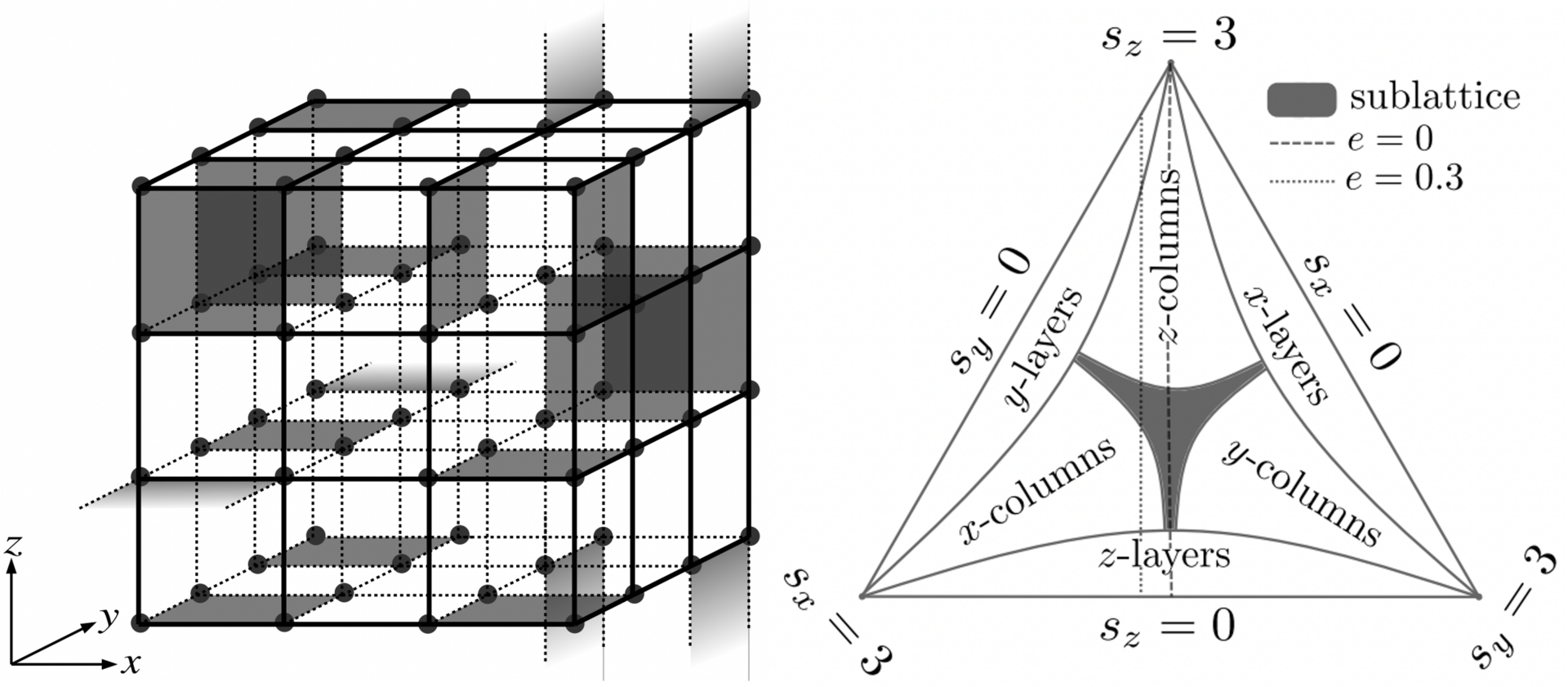
Figure on the left shows a configuration of hard plates at full packing on a 4x4 cubic lattice with periodic boundary conditions. Each plate touches exactly four sites of an elementary square plaquette of the cubic lattice, and each site is touched by exactly one such plate in the fully-packed case. Figure on the right shows the phase diagram of the fully-packed anisotropic hard-plate lattice gas on a cubic lattice in the space of anisotropic plate fugacities `s` . There are three kinds of phases: A sublattice-ordered phase, with lattice translation symmetry broken in all three Cartesian directions, layered phases with lattice translation symmetry broken only along one cartesian direction, and columnar ordered phases with lattice translation symmetry broken along two of the three cartesian directions.
This work is described in the preprints, "Spontaneous layering and power-law order in the three-dimensional fully-packed hard-plate lattice gas" G. Rakala, D. Mandal, S. Biswas, K. Damle, D. Dhar, R. Rajesh, Phys. Rev. E 107, 064137 and "Phases of the hard-plate lattice gas on a three-dimensional cubic lattice" D. Mandal, G. Rakala, K. Damle, D. Dhar, R. Rajesh", Phys. Rev. E 107, 064136
3.7 Quantum spin solver near saturation: QS3
Exact diagonalization (ED) method is a traditional and one of the most powerful numerical methods to understand the nature of quantum many-body systems from finite-size cluster calculations. This method enables us to obtain the eigenvectors and eigenvalues of our target Hamiltonian and evaluate all static, dynamical, and thermal quantities without any bias. However, the only disadvantage of the ED method is that the accessible system size is severely limited to small clusters even if we use the modern largest supercomputers. We develop new open-source software -quantum spin solver near saturation: QS3- based on the thick-restart/conventional Lanczos algorithm. This software is powerful for spin-1/2 XXZ-type quantum spin models near fully polarized states, which can be mapped to dilute hardcore Bose systems. All calculations in QS3 are performed in the U(1) and translational symmetry-adapted bases without using the bit representation, and this software can support large-scale finite-size calculations of more than 1000 sites (see Fig. 1). The users can also compute the dynamical spin structure factor by the continuous fractional expansion on the large-scale finite-size cluster (Fig. 2) . The open-source code is available from https://github.com/QS-Cube/ED.
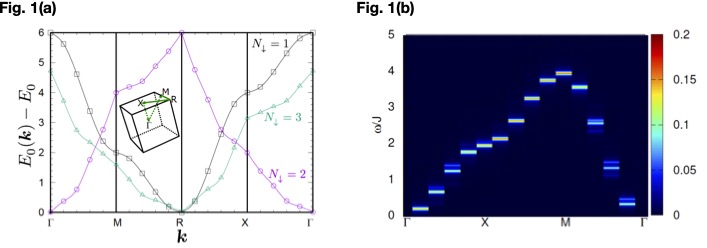
(a) The calculation example of the energy dispersions in the S=1/2 simple cubic antiferromagnetic Heisenberg model on the 10*10*10 sites finite-size cluster.
(b) The calculation example of the dynamical spin structure factor in the S=1/2 square-lattice antiferromagnetic Heisenberg model on the 10*10 sites finite-size cluster. The details of these computational results are shown in our paper.
This work was published as: "Quantum spin solver near saturation: QS3" Hiroshi Ueda, Seiji Yunoki and Tokuro Shimokawa, Comp. Phys. Commun. 277, 108369 (2022)
3.8 Quantum supremacy, sooner ?
The current generation of quantum computers are exploratory machines, capable of manipulating the information stored in tens of qu-bits, but subject to noise which severely limits the number of operations they can perform, and the accuracy to which they can work. One of the great challenges of this “noisy, intermediate-scale quantum” (NISQ) era, is to identify algorithms which can exploit the advantages of quantum calculation, while running on a technologically achievable device.
One of the leading contenders is the “quantum approximate optimization algorithm” (QAOA), a recipe for transforming a simple many-qubit wavefunction into one which encodes the solution to a classical optimization problem. The QAOA works by optimizing the schedule according to which unitary operators are applied to qubits, and is capable of solving problems which would be difficult on a classical computer. However the accuracy achieved by the QAOA depends heavily on the number of operations performed, with high levels of accuracy requiring more operations than can sensibly be performed on a NISQ device. Any algorithm which requires less operatorions to achieve the desired accuracy is therefore significant.
In this work, a collaboration of the TQM Unit with researchers from Tsinghua University, The Hong Kong University of Science and Technology, and the University of Wisconsion, Madison, we show how a dramatic speedup in the QAOA can be achieved through the use of an “adaptive bias” (ab-). In simulations of the solution of the canonical “Maxcut” problem, the ab-QAOA proved to be up to 18 times as fast as the standard QAOA, without any increase in the complexity of the hardware needed to run it. These results will facilitate the solution of classically hard optimisation problems using existing quantum computers, and could hasten the day when quantum computers show meaningful advantage over classical computers in real-world problems.
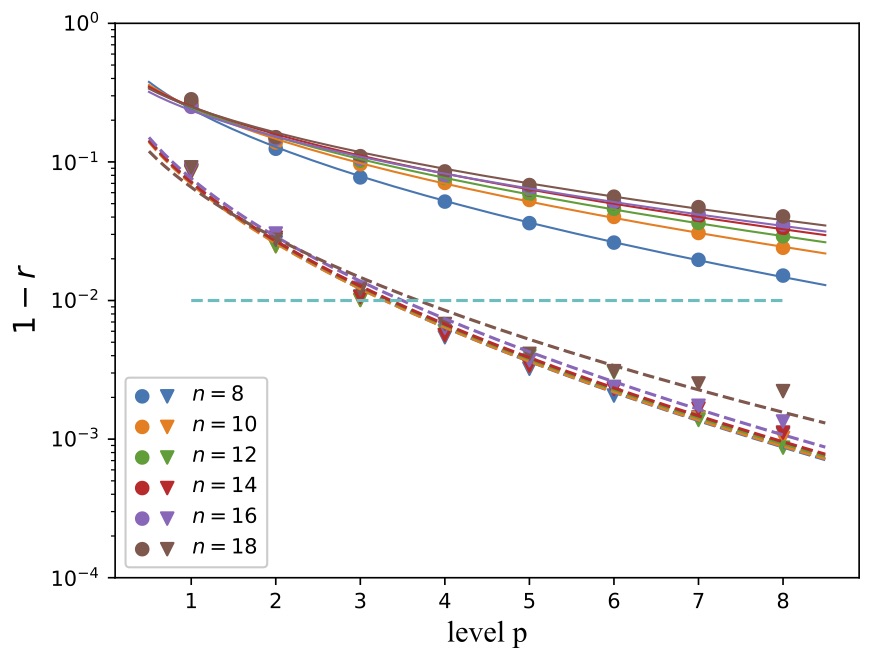
Relative error in the solution of the MaxCut problem using the quantum approximate optimization algorithm (QAOA, solid lines), and the QAOA with adaptive bias (ab-QAOA, dashed lines). Results are shown as function of the level of iteration p, for graphs encoded in circuits with n = 8 to 18 qu-bits. Once the adaptive bias is included, a much smaller number of iterations is needed to reach a target accuracy, leading to a dramatic speedup in the algorithm.
This work was published as “Quantum Approximate Optimization Algorithm with Adaptive Bias Fields”, Yunlong Yu, Chenfeng Cao, Carter Dewey, Xiang-Bin Wang, Nic Shannon, Robert Joynt, Phys. Rev. Research 4, 023249
4. Publications
4.1 Journals
- A. Scheie, O. Benton, M. Taillefumier, L. D. C. Jaubert, G. Sala, N. Jalarvo, S. M. Koohpayeh, and N. Shannon, "Dynamical Scaling as a Signature of Multiple Phase Competition in Yb2Ti2O7" Phys. Rev. Lett. 129, 217202
- Andreas Thomasen, Karlo Penc, Nic Shannon and Judit Romhányi, "Fragility of Z2 topological invariant characterizing triplet excitations in a bilayer kagome magnet" Phys. Rev. B 104, 104412
- Hyeok-Jun Yang, Nic Shannon and SungBin Lee, "Hidden phases born of a quantum spin liquid: Application to pyrochlore spin ice" Phys. Rev. B 104, L100403
- Max Hering, Han Yan and Johannes Reuther, "Fracton excitations in classical frustrated kagome spin models" Phys. Rev. B 104, 064406
- Rico Pohle, Han Yan, and Nic Shannon, "Theory of Ca10Cr7O28 as a bilayer breathing-kagome magnet: Classical thermodynamics and semi-classical dynamics" Phys. Rev. B 104, 024426
- Geet Rakala, Kedar Damle and Deepak Dhar, "Fractional Brownian motion of worms in worm algorithms for frustrated Ising magnets" Phys. Rev. E 103, 062101
- Tokuro Shimokawa, "Signatures of the finite-temperature mirror symmetry breaking in the S=1/2 Shastry-Sutherland model" Phys. Rev. B 103, 134419
4.2 Books and other one-time publications
[chapter in spin ice book]
4.3 Oral and Poster Presentations
Invited Talks at Conference
- Tokuro Shimokawa "Quantum spin solver near saturation (QS3) and its application to highly-frustrated spin systems" Frontiers of Quantum Many-Body Computation workshop, Online (2022.03.28)
- Nic Shannon "Connections between quantum spin liquids and quantum liquid crystals" FYR03 Quantum Liquid Crystals meeting, Online (2022.02.18)
- Tokuro Shimokawa "Frustration-induced multiple-q states in classical honeycomb lattice Heisenberg magnets" The International Conference on Frustration, Topology and Spin Textures (ICFTS), Online (2021.12.23)
- Nic Shannon "Ca10Cr7O28: deconstructing a complex quantum spin liquid" Pacifichem 2021, Online (2021.12.19)
- Nic Shannon "Rank–2 U (1) spin liquid on the breathing pyrochlore lattice" 3rd Quantum Matter Workshop, TDLI, Shanghai, Online (2021.08.23)
- Matthias Gohlke "Quantum Spin Nematics in Spin-1/2 Frustrated Ferromagnets" Tsung-Dao Lee Institute Youth Forum for Quantum Physics, Online (2021.05.21)
- Nic Shannon "Quantum spin nematics: quantum liquid crystals in magnets" International Conference on Quantum Liquid Crystals 2021, Online (2021.05.13)
Contributed Talks
- Kimberly Remund "Spin-1 Magnets: A u(3) Formalism" APS March Meeting, Online (2022.03.17)
- Matthias Gohlke "Spinon-like excitations in an anisotropic Kitaev-Gamma mode" JPS 77th Annual meeting, Online (2022.03.16)
- Jonas Sonnenschein "Bose Fermi mixtures in Heisenberg spin models" JPS 77th Annual meeting, Online (2022.03.16)
- Kimberly Remund "Spin-1 Magnets: A u(3) Formalism" JPS 77th Annual meeting, Online (2022.03.16)
- Leilee Chojnacki "Analogues of light and gravity in the collective excitations of quantum magnets" JPS 77th Annual meeting, Online (2022.03.16)
- Nic Shannon "Observing Magnetic Monopoles in Spin Ice via Electron Holography" JPS 77th Annual meeting, Online (2022.03.15)
- Geet Rakala "Efficient simulation of the Potts models using asymptotically exact sampling from a variational autoregressive neural net" JPS 77th Annual meeting, Online (2022.03.15)
- Tokuro Shimokawa "Sub-lattice multiple-q states in a frustrated honeycomb magnet - a possible scenario for Ca10Cr7O28?" JPS 2021 Autumn Meeting, Online (2021.09.20)
- Geet Rakala "Anisotropic hard plates on a cubic lattice" IOP CCP (Conference on Computational Physics) 2021, Online (2021.08.02)
Poster Presentations
- Kimberly Remund "New Method for Studying Dynamics and Thermodynamics of Spin-1 Magnets, Application to the Ferroquadrupolar Order" International Conference on Quantum Liquid Crystals 2021, Online (2021.05.13)
- Tokuro Shimokawa "High-field spin nematic state in S=1/2 J1-K square-lattice ferromagnet -Exact diagonalization study and related new open-source package QS3 -" International Conference on Quantum Liquid Crystals 2021, Online (2021.05.12)
- Matthias Gohlke "High-field spin-nematic state in the S=1/2 J-K square-lattice frustrated ferromagnet" International Conference on Quantum Liquid Crystals 2021, Online (2021.05.12)
Seminars
- Leilee Chojnacki "The Universe in a magnetic nutshell: ordered and disordered quantum magnets” OIST Internal Seminar series (2022.02.18)
- Tokuro Shimokawa "Unbiased numerical study of the quantum spin liquid material Ca10Cr7O28" Statistical physics seminar, University of Tokyo, Online (2021.11.08)
- Tokuro Shimokawa "Quantum spin solver near saturation -QS3- and its application to spin nematic study" Fujimoto-Mizushima Lab Seminar at Osaka Univ. Online (2021.08.20)
5. Intellectual Property Rights and Other Specific Achievements
Chapter: “Quantum Monte Carlo simulation of Quantum Spin Ice”, Nic Shannon, in "Spin Ice", Ed M. Udagawa and L. Jaubert, Springer, 2021.
6. Meetings and Events
6.1 Variations on a theme of Aharonov and Bohm
- Date: March 22
- Venue: Online
- Speaker: Prof. Sir Michael Berry / University of Bristol, UK
6.2 Evanescent-wave Johnson Noise
- Date: March 08
- Venue: Online
- Speaker: Prof. Robert Joynt / University of Wisconsin-Madison, USA
6.3 Intertwinned Néel and spin nematic orders in a square-lattice antiferromagnet
- Date: March 01
- Venue: Online
- Speaker: Prof. Bumjoon Kim / Pohang University of Science and Technology, Korea
6.4 Low Energy Structure of Spiral Spin Liquid
- Date: January 25
- Venue: Online
- Speaker: Dr. Han Yan / Rice University, USA
6.5 Topological transition by vector spin chirality on a triangular lattice
- Date: January 19
- Venue: Online
- Speaker: Associate Prof. Yusuke Nambu / Tohoku University, Japan
6.6 Clusters and orbitals in transition metal compound
- Date: December 15
- Venue: Online
- Speaker: Prof. Daniel Khomskii / Universitaet zu Koeln, Germany
6.7 Localisation phenomena in frustrated magnets
- Date: November 30
- Venue: Online
- Speaker: Prof. Claudio Castelnovo / University of Cambridge, UK
6.8 Quantum spin entanglement and criticality in 2D triangular magnet KYbSe2
- Date: November 16
- Venue: Online
- Speaker: Dr. Allen Scheie / Oak Ridge National Laboratory, USA
6.9 Realizations of Fractonic Quantum Phases and Quantum Spin Liquids
- Date: November 09
- Venue: Online
- Speaker: Prof. Yong-Baek Kim / University of Toronto, Canada
6.10 Anomalies in (2+1)D Symmetry-Enriched Topological Phases
- Date: October 26
- Venue: Online
- Speaker: Dr. Daniel Bulmash / University of Maryland, USA
6.11 Universal transport features in spin-orbit-coupled quantum wires
- Date: October 12
- Venue: Online
- Speaker: Dr. Chen-Hsuan Hsu / RIKEN, Japan
6.12 Exploring competing electronic phases under extreme conditions in superconducting FeSe1-xSx
- Date: September 30
- Venue: Online
- Speaker: Prof. Amalia Coldea / University of Oxford, UK
6.13 Witnessing entanglement in magnets using neutrons
- Date: September 02
- Venue: Online
- Speaker: Prof. Alan Tennant / Oak Ridge National Laboratory, USA
6.14 Theory of multipole fluctuations mediated superconductivity and charge-loop current phase
- Date: July 15
- Venue: Online
- Speaker: Dr. Rina Tazai / Nagoya University, Japan
6.15 Topological Magnons from “nematicity”
- Date: July 01
- Venue: Online
- Speaker: Assistant Prof. Yutaka Akagi / The University of Tokyo, Japan
6.16 Quantum phase transitions between orthogonal and normal fermions in metals and semi-metals
- Date: June 24
- Venue: Online
- Speaker: Prof. Snir Gazit / The Hebrew University of Jerusalem, Israel
6.17 Coherent versus incoherent excitons: Stability, time-dependent ARPES spectrum and Floquet topological phases
- Date: June 17
- Venue: Online
- Speaker: Prof. Gianluca Stefanucci / University of Rome Tor Vergatah, Italy
6.18 Ferroelectricity in novel frustrated quantum magnets
- Date: June 10
- Venue: Online
- Speaker: Prof. Andrey Zheludev / Laboratory for Solid State Physics, ETH Zürich, Switzerland
6.19 Two charge sectors in the strange metal regime of overdoped cuprates
- Date: June 03
- Venue: Online
- Speaker: Prof. Nigel Hussey / University of Bristol, UK / Radboud University, Netherlands
6.20 Topological frustration in a quantum spin ladder
- Date: May 20
- Venue: Online
- Speaker: Prof. Michael Lawler / Cornell University, USA
7. Other
Nothing to report.




